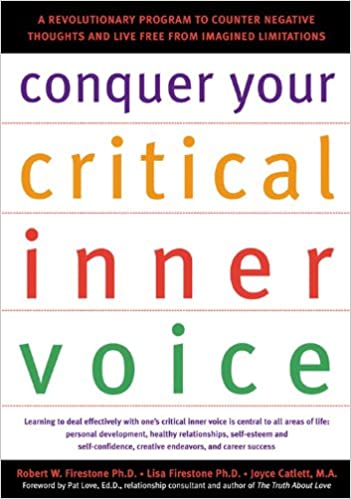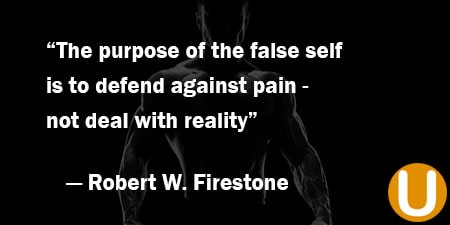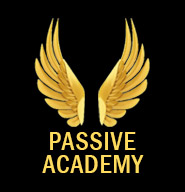Conquer Your Critical Inner Voice Summary
- Book by Robert W. Firestone, Lisa Firestone, Joyce Catlett
The Book in 1 Sentences
Conquer Your Critical Inner Voice: A Revolutionary Program to Counter Negative Thoughts and Live Free from Imagined Limitations
“Conquer Your Inner Critical Voice can help you expose and challenge destructive ways of thinking that seriously impair your sense of self, your spirit, and your ability to achieve the things in life that matter most to you.
Many limitations that people face in life are self-imposed and based on unrealistic and negative views they have of themselves and others.
Therefore, the goals of this book are:
(1) to illuminate the forces within us that contribute to many of our problems in living and that cause us much unnecessary pain and distress; and
(2) to provide you with methods for challenging and modifying these forces so you can realize your own unique potentialities.” ~ Robert W. Firestone, Lisa Firestone, Joyce Catlett
5 BIG Ideas
1. “If you are distressed by anything external, the pain is not due to the thing itself but to your own estimate of it; and this you have the power to revoke at any moment.”
2. “It is not easy to break with your early programming and, as we have seen, there can be no growth without anxiety.”
3. Instead of feeling guilty, feel compassion for yourself and the others involved and identify the behavior(s) you intend to change in the future.
4. “To be fully alive means opening yourself up to all dimensions of life—sadness as well as joy, and pain as well as pleasure.”
5. “Attaining the kind of life we want to live and developing our human potentialities is a lifelong project that involves dedication and a focus on what is essentially human in all of us.”
Conquer Your Critical Inner Voice Summary
“The guidelines and exercises provided in this book point you toward leading a better life by identifying the critical inner voice, understanding its sources, and then taking action against its dictates.” ~ Robert W. Firestone, Lisa Firestone, Joyce Catlett
So, let’s dive right into some of the biggest ideas of the book…
1. The Real You Vs the Critical Inner Voice
“Depending on which part of your personality is more prominent at a given time, the real you or the critical inner voice, you will express an entirely different point of view, and your behaviors and interactions with others will be different.
Perhaps you have noticed this interesting phenomenon in the people closest to you; they can be very different when they seem to be “themselves” than when they do not seem themselves.
When they are themselves, they are usually relaxed and far more likable. When they are being influenced by their inner critical voice, they are typically more uptight and unlikable.”
I DO AGREE with that… I’ve experienced this phenomenon many times before!!
It really feels like there is an “enemy” lives inside my head!
And that’s what Dalai Lama says: “We allow ourselves to be ruled by our thoughts and emotions, and furthermore… we allow our thoughts and emotions to be determined by our negative impulses and other afflictions of the mind… If we continue to allow this situation to occur, it can only lead to misery and suffering… Whatever brings disaster or harm should be called an enemy, so this means that the ultimate enemy is actually within ourselves.”
So, the goal is to recognize this inner enemy – the critical inner voice – and STOP IT!
Got it?! Now let’s move on…
2. What We tell Ourselves
“If, during the past week, you observed that your mood switched—for example, from feeling relatively happy and content to feeling down—try to recall the event or interaction that occurred immediately prior to the shift in your feelings.
After thinking about the details of the event or conversation, try to remember what you were telling yourself at the time. Although many situations and encounters can be distressing or anxiety-producing, it is important to reemphasize that the way we interpret these events or situations is the crux of the problem.
What we tell ourselves about the event, about ourselves, and about the other person or people involved is far more crucial in determining our feelings and our state of mind than the event itself.”
It's not the event itself that caused that pain to you… It’s how you perceived it…
How to deal with self talk!
Look, there are 3 different things here:
1. The event itself.
2. The event leads to a thought (an interpretation of the event).
3. Then, the thought in turn evokes an emotion (and a reaction).
In the 7 habits of highly effective people, Stephen Covey says: “Look at the word responsibility—’response-ability’—the ability to choose your response. Highly proactive people recognize that responsibility. They do not blame circumstances, conditions, or conditioning for their behavior. Their behavior is a product of their own conscious choice, based on values, rather than a product of their conditions, based on feeling.”
And in Meditations, Marcus Aurelius says: “If you are distressed by anything external, the pain is not due to the thing itself but to your own estimate of it; and this you have the power to revoke at any moment.”
It’s all about learn how to observe the thoughts that are creating our moods in order to control our reactions and our lives. Got it?!
3. Guilt
“Guilt can be defined as self-critical feelings and attitudes that are experienced in relation to our actions, as well as in relation to our thoughts and feelings we see as unacceptable...
However, even in situations where you know you are in the wrong, it serves no purpose to attack yourself for the negative effects of your behavior.
It is much more constructive to identify the critical inner voices that intensify your guilty feelings, feel compassion for yourself and the other person, and plan ways to change your behavior in future interactions.”
Guilt is overwhelming… It makes us immobilized in the present over something that has already taken place and cannot be changed by any means!
This is the unhealthy way of feeling regret…!
Look, there are 2 ways to respond to something bad you did:
1. You can attack yourself with guilt and waste of emotional energy.
2. Or, it’s OK to regret… Feel compassion for yourself and the others involved and identify the behavior(s) you intend to change in the future.
It makes a LOT more sense to choose the second option. That’s how you can live a more constructive living, right?
4. How to Deal with Depression
“To combat the voices that contribute to depression, it is helpful to:
1. Identify and challenge the negative thoughts and beliefs you experience early in the self-destructive cycle.
2. Talk to a close friend who tends to have a more optimistic outlook. Talking to someone who is also down or cynical about life can actually make you feel worse.
3. Force yourself to engage in activities that you have found pleasurable in the past. Even if they don’t seem appealing right now, they will help you start to overcome apathy, indifference, and lack of energy that are major symptoms of depression.”
It’s our critical inner voice, the negative destructive inner talk that leads to depression… Identify these thoughts as soon as possible when they attack you…
Talk to your best friend, go out for a walk, go swimming… try as hard as you can to do the things that usually makes you feel happy…
Do it even if you don’t feel like it right now, Just DO IT...!

GET Blinkist 7 Days FREE Trial
3000+ Book Summaries
(Audio and Text)
5. The Unexamined Life is Not Worth Living!
“Each of us has the goal of creating the best life possible for ourselves and our loved ones.
For centuries, philosophers and religious teachers have attempted to define what it means to live the “good life.” Their ideas on the subject differ, yet they all hold one belief in common—that is, that “the unexamined life is not worth living,” as Socrates put it.
We can fulfill our human potential only if we seriously consider our own wants, desires, goals, and ideals, and then make conscious choices as we search for personal meaning in our lives.”
Stop for 5 minutes (or as much time as you need) and think about that…
- My purpose in life is: …………………….
- My biggest goals are (write 5): …………………………..
- I believe that (write 5): ………………….
The authors also tell us that “It is not easy to break with your early programming and, as we have seen, there can be no growth without anxiety.”
6. What is the Good Life?
“The good life is not achieved by seeking to be “happy” in the sense that this word is often used—to describe the absence of unpleasant experiences such as fear, anxiety, or pain.
To the contrary, to be fully alive means opening yourself up to all dimensions of life—sadness as well as joy, and pain as well as pleasure.
It also involves committing yourself to a search for personal meaning and transcendent goals—of which happiness is a by-product.”
Having a good life is not about living in a “dream” where nothing “bad” happens, and singing all the time! It’s impossible!
Life is a MIX of good and bad things. It’s a mix of happiness and sadness… In order to feel the pleasure, you must try the pain first…
It’s all about having a purpose, a meaning, a big goal you wake up every single day to go closer to… It’s HOPE that keeps us alive and happy… It’s our hope that makes us stronger when pain comes to our door…
Remember that “Attaining the kind of life we want to live and developing our human potentialities is a lifelong project that involves dedication and a focus on what is essentially human in all of us.”
“Happiness is a by-product” … That’s true…
That was my Conquer Your Critical Inner Voice summary, a very quick look at this great book. This book is for everyone wanna make a real change in his life... If you haven’t read it yet and you’re interested in it, get a copy. There is a HUGE amount of wisdom and life-changing exercises and tips in this book, and we’ve only touched on a tiny bit of it.
Buy The Book: Conquer Your Critical Inner Voice

GET Blinkist 7 Days FREE Trial
3000+ Book Summaries
(Audio and Text)






